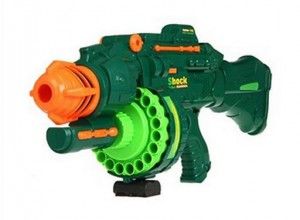Gun safety legislation comes under fire from unusual suspects
 Whatever their enthusiasm or seriousness, California gun users have a new set of obstacles, thanks to fresh legislation intended to increase firearm safety. Both changes have raised pointed questions about naivety on technology.
Whatever their enthusiasm or seriousness, California gun users have a new set of obstacles, thanks to fresh legislation intended to increase firearm safety. Both changes have raised pointed questions about naivety on technology.
Senate Bill 199 was introduced by state Sen. Kevin de León, D-Los Angeles, now the Senate president pro tem. It was passed last year and signed into law by Gov. Jerry Brown. It targeted BB and pellet guns, mandating bright colors meant to distinguish them from “real” guns. First implemented in January, the so-called Imitation Firearms Safety Act has been working its way slowly across the state.
But it has aroused particular disbelief among police on the one hand and hobbyists on the other.
According to a statement from de Leon’s office, the well meaning legislation sought to:
“Help law enforcement distinguish toy guns from the real thing when they are confronted with youngsters brandishing play firearms. Currently toy guns such as airsoft and BB guns are not included in California’s legal definition of imitation weapons. SB199 requires these look-a-likes to have their entire exterior surface painted a bright color, or to feature florescent strips in salient parts of the gun to make them easily distinguishable.”
Support for SB199 gathered in response to the kind of police altercation that makes headlines — armed but mistaken confrontations with minors. Recently, two LAPD officers fired on a South L.A. teenager holding a replica thought to be a handgun. Although the teen was not wounded, a nearby 15-year-old was.
While pellet gun hobbyists have balked at the legislation — popular Airsoft guns base their appeal on their realistic look and feel — gun manufacturers and police unions have registered even stronger opposition. As the Los Angeles Times reported, they have long claimed “the law will do little to prevent mistaken shootings and could actually make things more confusing for officers who must make split-second decisions whether to fire or not.”
In the summer of 2013, the Los Angeles Police Protective League, an LAPD union, warned the city of Los Angeles against similar regulations under municipal consideration. League President Tyler Izen pulled no punches:
“This is a horrible idea that may cause officers to hesitate when confronted with a colored rifle when we already know that fully operable handguns and rifles have been painted bright colors.”
In a dramatic demonstration of Izen’s objections, a quick search for pink firearms at the website GunsAmerica.com yielded over 250 results, including both handguns and rifles that incorporate the kind of vibrant, telltale coloration required by SB199.
Microstamping guns
The second bill is AB1471. It was signed into law in 2007 by Gov. Arnold Schwarzenegger, a Republican. It sought to reduce crime through “microstamping,” a process that would theoretically enable law enforcement to trace every cartridge left at the scene of a crime back to the gun from which it came.
AB1471 did not take effect until 2013. It since has became the subject of intense litigation in the courts. And now, a key decision from a district court judge has pushed the case further up the judicial food chain. Recently handed an adverse ruling in the form of a summary judgment against them, the anti-microstamping plaintiffs have appealed the judge’s decision to the Ninth Circuit Court of Appeals. Expectations have hardened that the case could continue to rise, on appeal, all the way to the U.S. Supreme Court.
The terms of AB1471 required firearms manufacturers “to engrave the serial number in the gun’s chamber so that it becomes stamped on each bullet as it is fired,” as the San Francisco Chronicle reported. Although law enforcement groups did support the law, Attorney General Kamala Harris did not authorize its implementation until she was convinced two years ago the necessary technology was available.
Gun manufacturers, however, vehemently disagreed the necessary process was feasible. As a result, Fox News reported, new models of firearms have begun to disappear from California stores:
“Since the law took effect in 2013, no manufacturer has made a new firearm that complies with the requirement. Two major manufacturers, Smith & Wesson and Sturm, Ruger & Co., announced last year they would stop selling new firearms in the California market, and blamed the microstamping law. The technology has been demonstrated, but gunmakers say requirements that each new model, or even modification, must be re-tested for compliance makes the entire scheme unworkable.”
The controversy led to accusations that microstamping would effectively phase out ownership of new guns in California.
Related Articles
Budget For A Paycheck?
JUNE 14, 2011 By KATY GRIMES Commentary If you were presented with doing your job or having your paycheck withheld,
A Green CARB Overload
DEC. 22, 2010 While the rest of the world begins to show some sense of reality on global warming hysteria,
Fracking watch: Argentina figures out what CA hasn’t
May 3, 2013 By Chris Reed The “brown energy” revolution is under way and nothing is going to prevent it



